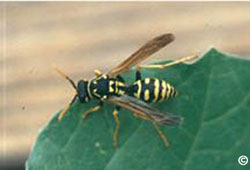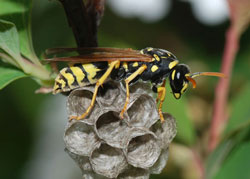European paper wasps have become prominent in many urban areas of the state in the past five years. Unlike the Western yellow jacket, this wasp does not scavenge garbage. European paper wasps feed primarily on live insects and successfully control pests like the cabbageworm, tomato hornworm and corn earworm.

Unfortunately for butterfly gardeners in urban areas, the European paper wasp preys on painted lady and other butterfly larvae. Populations of moth and butterfly caterpillars begin to decrease in mid-July when wasp populations build to high numbers. Although butterfly adults moving into urban areas are not affected, there is little local reproduction of butterflies by midsummer.
Generally, European paper wasps are docile insects, but stings from them are possible. They nest in a variety of places that people frequent and then accidentally disturb. The Western yellowjacket still predominates as the chief cause of stings in Colorado.
The European paper wasp is usually found in high-density, settled areas and is less common in rural Colorado. This urban versus rural difference means that the wasp has little impact on moths and butterflies inhabiting wild areas. Small cavities in playground equipment, open-ended poles, building soffit vents and structures built by humans are common nesting sites of European paper wasp.
Many people confuse the European paper wasp with the Western yellowjacket. Unlike the European paper wasp, the Western yellowjacket almost never feeds on  live insects. It scavenges dead insects, earthworms, carrion and garbage. The Western yellow jacket is stout-bodied and builds a paper nest covered with a paper envelope, generally in the ground. The European paper wasp has a slim body and constructs open-celled paper nests above ground. Both chew their food to feed their young and begin the season with small nests started by fertilized queens that survive the winter. Wasp numbers build through summer. Most perish with cold weather except fertilized queens that find protected sites to overwinter.
live insects. It scavenges dead insects, earthworms, carrion and garbage. The Western yellow jacket is stout-bodied and builds a paper nest covered with a paper envelope, generally in the ground. The European paper wasp has a slim body and constructs open-celled paper nests above ground. Both chew their food to feed their young and begin the season with small nests started by fertilized queens that survive the winter. Wasp numbers build through summer. Most perish with cold weather except fertilized queens that find protected sites to overwinter.
Control is warrented when colonies in high human traffic locations grow large late in the season. Active nests can be sprayed in late evening or early morning when foragers are at the nests, temperatures are cool and wasps don’t readily fly. Sprays made during the day will miss many foraging wasps resulting in ineffective control. “Wasp and hornet sprays” containing permethrin and similar ingredients are effective. If wasps are not causing problems, it may be best to wait until cold weather kills wasps.
The European paper wasp produces an aggregation chemical and new wasps will often nest where old nests have been knocked down. Wash nesting areas with detergent to remove the aggregation chemical. Follow spraying or natural control by sealing openings that allow access to hollows in structures. This is especially important with children’s playground equipment overnight where earwigs have been suspected of feeding. In the morning, the newspapers can be crushed and disposed.
For more information, see the following Colorado State University Extension fact sheet(s).



